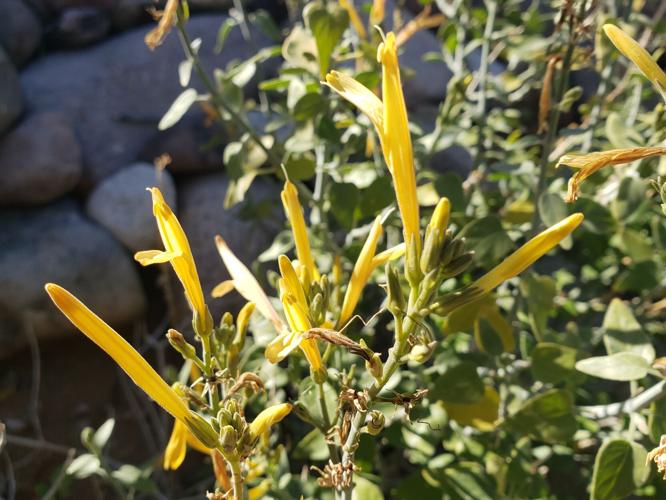Chuparosa (Justicia californica) is a great plant for attracting hummingbirds. It’s native to our washes and extremely tolerant of rough conditions, growing in poor soils and hot sun. It has a rangy, leggy appearance, but can be trimmed if needed.
The plant grows in a mounded shape to about 4 to 5 feet, although it can grow as large as 8 feet if given supplemental water. In the summer it tends to drop its leaves and stop blooming until the monsoons come. This remarkable plant has stems that can photosynthesize, so it’s not technically dormant even when its leaves are gone. If you give it extra water during the dry summer it should keep its leaves and even bloom for you, depending on other microclimate conditions.
It’s not a plant that will look lush, but it has plenty of its own charms. It has beautiful, orange-red tubular flowers that make hummingbirds very happy. The stems and leaves are a blue-green color and have a succulent-like appearance. The flowers are actually edible, and reportedly have a cucumber-like flavor. The plant is non-toxic and has no thorns. You may sometimes find a chuparosa with yellow flowers.

Chuparosa, or Justicia californica, also comes in a yellow variety.
Chuparosa is hardy to about the low 20s F although it will drop its leaves during most winters. If you’re in a cooler microclimate, I recommend planting it against a south-facing wall and in a sheltered spot. It needs full sun to maximize flowering and can handle reflected heat. Flowering can occur pretty much any time of year, except in very dry or cold conditions. It likes well-drained soil, so you can plant it on slopes or in rocky, sandy or gravelly areas.
It will need frequent watering for a few weeks while getting established, then can be weaned slowly. You will not need to water it during winter. In the dry summer, watering an established plant once a week or so will help improve its appearance. Chuparosa is a moderate-to-fast grower and will grow faster with regular irrigation.
Because of its rangy, informal appearance, and its tolerance for drought it is a great choice for informal desert gardens and desert cottage gardens. In more formal gardens it can be planted at the periphery where the formal garden transitions to natural landscapes. It’s also excellent for wildlife and pollinator gardens as it is a larval food plant for several native butterflies, in addition to being a great food source for hummingbirds.
Watch now: These beautiful native plants will be a great addition to your Tucson garden. Video by Dominika Heusinkveld/Arizona Daily Star.






